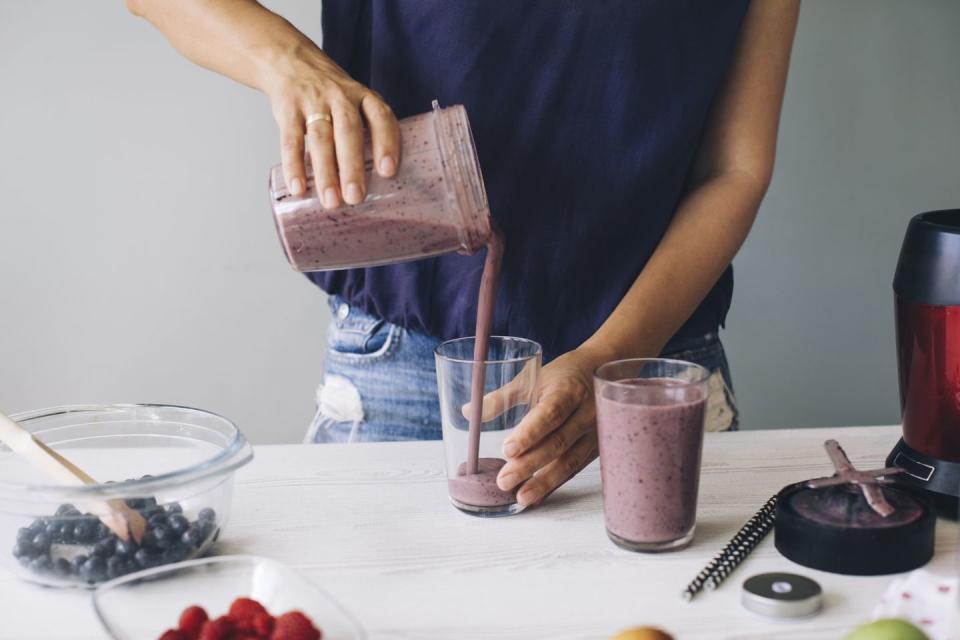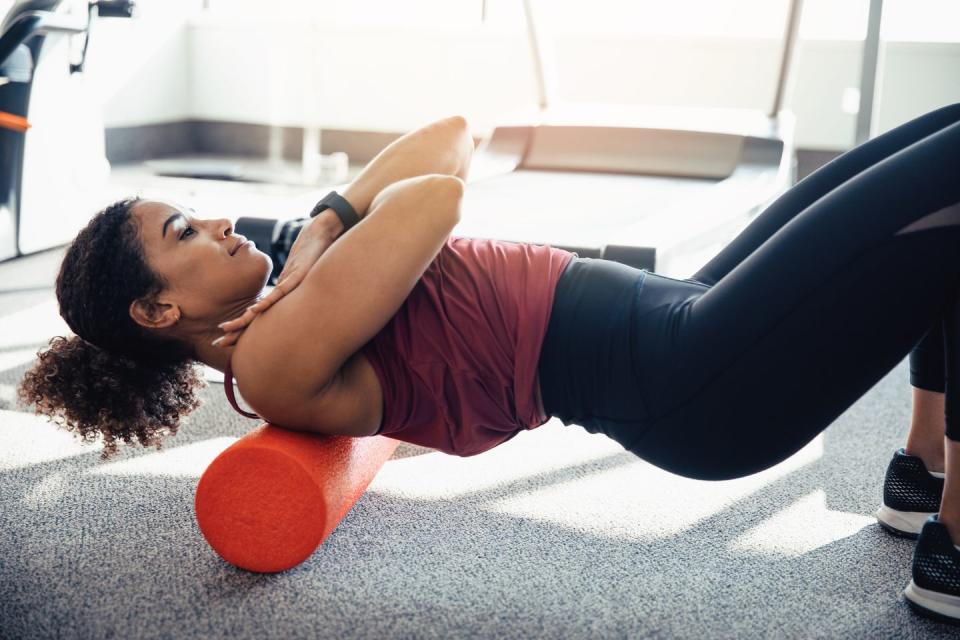12 Tips to Optimize Muscle Recovery, According to Fitness Experts

Have you just started up with a new exercise regimen, only to feel sore and tired throughout the week? You're likely experiencing delayed onset muscle soreness (DOMS), a type of soreness that typically begins to develop 12-24 hours after exercise but may result in the greatest level of discomfort and pain between 24-72 hours after exercise. DOMS is common when you perform an exercise that you're not used to or haven't done in a while. But we know that exercise has a slew of health benefits, and in order to stay consistent with a workout regimen, proper recovery is essential.
"Recovery has always been important for athletes, but it is becoming more and more important for the everyday person," says Dr. Jason Wersland, DC, Founder and Chief Wellness Officer of Therabody. "People are recognizing how much better they feel when they are prioritizing recovery day to day. In the long term, proper recovery reduces inflammation, aids in injury prevention, and increases range of motion."
Not only will you feel better when you focus on recovery, but Wersland shares that the consequences of poor recovery can build up over time which is something you'll want to avoid. "Excessive overload on muscles can hinder growth, slowly impact our immune system, and at its worst can cause serious muscle damage," he says. "Our body needs down time, it's essential." Try these comprehensive strategies and tips to start prioritizing your workout recovery and give your body some much needed TLC.
Don't skimp on your warm-up

"True recovery actually starts before your workout," Wersland says. He stresses that a proper dynamic warm-up is essential for preparing your body for large dynamic movements it will perform during the workout. "Whether you're an elite athlete or a weekend warrior, an effective warm-up routine is vital to your recovery routine."
Build in time for a proper warm-up before you start breaking a sweat, which can help decrease risk of injury and even minimize DOMS. Dynamic stretching is the preferred form of stretching pre-workout and involves loosening your joints to improve range of motion and blood flow. By actively moving joints and muscles in exercise-specific motions, you'll prime your body for those moves during the workout. Some great examples of dynamic stretching include walking lunges, hip circles, torso twists, and leg swings.
Commit to five minutes

Not making the time for even a short cooldown post-workout can set you up for injury and soreness. Move muscle recovery along by taking at least five minutes to do some static stretching, which involves moving a muscle or joint as far as it can go and then holding it for a period of time. While dynamic stretching pre-workout involves staying active and moving, static stretching requires you to stay still and breathe into the stretch. Static stretches like a quadriceps stretch, hamstring stretch, and tricep stretch are all examples that can help provide relief and relaxation of the muscles post-workout.
Catch those Zzz's

Sleep is your body's time to repair, recuperate, and recover. Your emotional, mental, and physical health all benefit from adequate sleep. "We are finding that sleep has so many more benefits than we previously understood... getting a good, restorative night's sleep is the best way our bodies can really recover from within," Wersland adds. Try staying away from screens an hour or two before bed and use your bed only for sleep; you want the bed to be a sanctuary for snoozing, not a stressful place where you answer work emails all day long. If you can go to sleep and wake up at the same time every day, that may help you create a more regular bedtime routine.
Refuel post-workout

Wersland says that recovery isn't just limited to stretching, but "how you are treating your body from within, and what behaviors you practice... from diet to sleep." Choosing the best muscle recovery foods after your sweat session can help rebuild your muscle protein and glycogen stores.
Although protein plays a big role in building and repairing muscle, carb and protein together make for a stellar recovery combo. You want to look for a balance of 3:1 carbs to protein in your post-workout snack or meal, and aim to eat within 45 to 60 minutes after your workout so your muscles will absorb nutrients most efficiently. A Greek yogurt parfait, protein bar, or even chocolate milk make for great options. And while a smart post-workout snack plays a role in recovery, a well-balanced diet throughout the entire week is just as important.
Roll it out

From helping to relieving muscle tension and soreness to increasing muscle length and improving range of motion, say hello to your new favorite recovery tool. A foam roller is an affordable and efficient piece of recovery equipment that can be used pre-workout to help warm up or post-workout to cooldown. By taking the time to foam roll, especially after a tough workout, you can help to promote the recovery process.
Research suggests that massage in general is one of the most effective methods of reducing DOMS and perceived fatigue post-workout, and a foam roller can be a great self-massage tool to assist with that. Foam rollers come in different types, most commonly in a cylinder formation made of firm compressed foam. Some varieties feature bumps or ridges on them, and newer options even vibrate which is thought to alleviate pain, allowing you to foam roll for longer and enhance recovery.
Drink up

"Staying hydrated is something that is easy to do, and makes all the difference in how your body recovers." Wersland shares. Optimal hydration means getting enough water before, during, and after your workout. The key is to listen to your body, and know that if you're feeling thirsty chances are you may already be dehydrated. The American Council on Exercise recommends the following:
Drink 17 to 20 ounces of water two hours before the start of exercise.
Drink 7 to 10 ounces of fluid every 10 to 20 minutes during exercise.
Drink 16 to 24 ounces of fluid for every pound of body weight lost after exercise.
If you're working out for an hour or less, good old H2O should suffice. But coconut water, essentially nature's sport drink, is an alternative that is rich in electrolytes and may assist with recovery. Although hydration is important, Wersland adds that you'll get the best results if you are holistic in your approach and being thoughtful about your nutrition, sleep, and mental health.
Stretch every day, in the morning

Don't just limit stretching to right before and after your workout. Stretching first thing in the morning has many benefits, including relieving tension or pain from sleeping the night before. Most importantly, morning stretches can help increase blood flow to muscles and joints and prepare your body for the day ahead. Try this quick morning stretch sequence that can be done in less than five minutes:
Start lying in bed and gently hug your knees into your chest for 30 seconds.
Slowly lower your knees down to the left side of your body and keep your torso toward the ceiling; hold for 30 seconds, then switch sides.
Next, sit up and fold forward for about a minute.
End in child’s pose for 60 seconds.
Go easy on alcohol

Is too much booze on the weekends sabotaging your workouts? Research suggests that alcohol can actually interfere with muscle recovery. Even if you consume adequate protein after a workout, findings from this study suggest that optimal nutrient provision couldn't overcome the negative impact of alcohol on myofibrillar protein synthesis. Try to cut back or opt for a dry month challenge (you don't have to wait until January to give it a go).
Try compression clothes

Research suggests that compression clothes may help to speed up recovery, particularly after intense exercise. The pressure provided from compression garments like socks or sleeves may help actually improve circulation, which in turn assists with removing metabolic waste from muscles. These improvements can promote the flow of oxygenated blood to areas in the body like tissues that need repairing and rebuilding. If you're new to the compression gear game, start by trying out a pair of compression tights or socks.
Stay active, even on rest days

Incorporating rest days into your workout routine is imperative and you should always prioritize listening to your body. But recovering does not mean being completely sedentary. In fact, sitting all day can actually delay muscle rehabilitation, as it can lead to tightness in the hip flexors and hamstrings. Light, gentle movement like a brisk walk or an easy yoga flow can help improve circulation and promote muscle recovery.
Try percussive therapy

Investing in a muscle recovery tool like a massage gun can be worth it, especially if you're short on time. Wersland recommends massage guns like Theragun since they are quick and effective, noting that you need to spend no more than two minutes treating a particular muscle group with percussive therapy. The vibration helps enhance circulation and can alleviate pain, making a massage gun the perfect solution for rehabbing stiff muscles. "Theragun and Recovery Pump pneumatic compression boots to increase blood flow and reduce tension are recovery solutions I use daily," Wersland shares.
Schedule in downtime

"True recovery can only happen if your body spends a considerable amount of time in a parasympathetic state," Wersland shares. He recommends a 10-minute meditation at least once a day to put the mind and body in a parasympathetic state for further recovery time. "You are hindering muscle recovery when you are not thinking about your body and health holistically, and not thinking about recovery from within," Wersland adds. If you're new to meditation, try a top-tested meditation app pick that blends auditory and visual guidance.
Now that you've identified where to improve your muscle recovery process, incorporate these changes gradually. Remember that taking the time and making the effort to properly recover is a form of self-love and a way to honor your body. "The quality of your muscle recovery will determine your ability to continue doing what you love - whether that is playing a professional sport, hiking, playing an instrument, or any of the millions of things people do that require healthy bodies," Wersland says.
You Might Also Like

